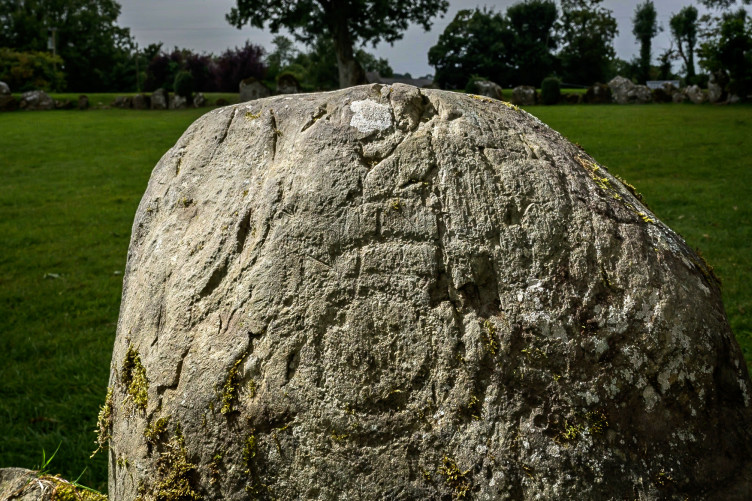
On Wednesday, 17 August 2022, there was a remarkable discovery of carvings on one of the stones of Grange Stone Circle at Lough Gur, Co. Limerick, by Ken Williams, a leading Irish archaeological photographer. Lough Gur Development was founded in 1969 and officially inaugurated in 1993 to promote, preserve and protect the history, archaeology, folklore and environment of the surrounding area.
The stone circle at Grange, within the development, comprises a ring of continuous uprights up to 2.8m high, with a diameter of 45m and backed by an earthen bank 9m wide and about 1.2m tall. It is the largest standing stone circle in Ireland, 150 feet in diameter and enclosed by 113 standing stones. The largest stone is Rannach Chruim Duibh (Crom Dubh’s Division) and is over 13 feet high and weighs 40 tons
Ken Williams has developed methods of lighting stones to photograph them to maximum effect and he has found a number of new carvings over the years in this way. He discovered the carvings when he returned to check the stones at Grange Stone Circle for carvings as part of his current research.
These new Lough Gur carvings are particularly spectacular, with concentric circles and arcs placed on the back and sides of the fourth stone to the north of the entrance passage, referred to as Stone 9 in the published site plans. Dr Elizabeth Shee Twohig, who has published extensively on megalithic and rock art, has said of the discovery that
“the carvings are quite like those at passage tombs in the North and East of the country, such as Knowth and Newgrange, but there is only a single carved stone of this kind in Munster or Connaught. It is possible that the stone is contemporary with the banked enclosure henge at c.3000 BC and was incorporated into the circle built inside the enclosure at a slightly later date.”
Minister Noonan welcomed the discovery at Grange Stone Circle, noting that
“this is a site that has both captivated and intrigued locals and visitors for many years. It shows yet again the capacity our national monuments have to surprise and engage us.”
Minister O’Donovan, who has had a long connection with Lough Gur stated,
“This is a very interesting find and I look forward to visiting the site again soon and seeing first-hand these intriguing designs.” He added “I would like to thank Mr. Williams for notifying the Office of Public Works and the Department of Housing, Local Government and Heritage, as this ensures that the discovery can be appropriately recorded. I would encourage members of the public to contact the OPW and the Department immediately if they find anything unusual, as everyone can play their part to protect our past.”
Ken Williams plans to publish the photographs of the carvings in an academic paper, which will describe the art and discuss comparable examples elsewhere.